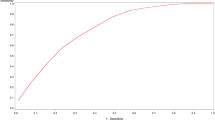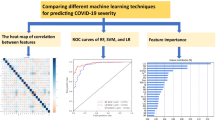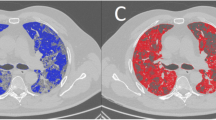Abstract
Purpose
Due to the increased risk of acute cardiac injury (ACI) and poor prognosis in cancer patients with COVID-19 infection, our aim was to develop a novel and interpretable model for predicting ACI occurrence in cancer patients with COVID-19 infection.
Methods
This retrospective observational study screened 740 cancer patients with COVID-19 infection from December 2022 to April 2023. The least absolute shrinkage and selection operator (LASSO) regression was used for the preliminary screening of the indices. To enhance the model accuracy, we introduced an alpha index to further screen and rank the indices based on their significance. Random forest (RF) was used to construct the prediction model. The Shapley Additive Explanation (SHAP) and Local Interpretable Model-Agnostic Explanation (LIME) methods were utilized to explain the model.
Results
According to the inclusion criteria, 201 cancer patients with COVID-19, including 36 variables indices, were included in the analysis. The top eight indices (albumin, lactate dehydrogenase, cystatin C, neutrophil count, creatine kinase isoenzyme, red blood cell distribution width, D-dimer and chest computed tomography) for predicting the occurrence of ACI in cancer patients with COVID-19 infection were included in the RF model. The model achieved an area under curve (AUC) of 0.940, an accuracy of 0.866, a sensitivity of 0.750 and a specificity of 0.900. The calibration curve and decision curve analysis showed good calibration and clinical practicability. SHAP results demonstrated that albumin was the most important index for predicting the occurrence of ACI. LIME results showed that the model could predict the probability of ACI in each cancer patient infected with COVID-19 individually.
Conclusion
We developed a novel machine-learning model that demonstrates high explainability and accuracy in predicting the occurrence of ACI in cancer patients with COVID-19 infection, using laboratory and imaging indices.






Similar content being viewed by others
Data availability
The raw data supporting the conclusions of this article will be made available by the authors, without undue reservation.
References
Abdeldayem EH, Raief Mosaad BM, Yassin A, Abdelrahman AS (2023) Cardiac MRI in patients with Covid-19 infection. Eur Radiol 33(6):3867–3877. https://doi.org/10.1007/s00330-022-09325-x
Ahmad F, Kannan M, Ansari AW (2022) Role of SARS-CoV-2-induced cytokines and growth factors in coagulopathy and thromboembolism. Cytokine Growth Factor Rev 63:58–68. https://doi.org/10.1016/j.cytogfr.2021.10.007
Ammirati E, Lupi L, Palazzini M, Hendren NS (2022) Prevalence, characteristics, and outcomes of Covid-19-associated acute myocarditis. Circulation 145(15):1123–1139. https://doi.org/10.1161/CIRCULATIONAHA.121.056817
Asteris PG, Kokoris S, Gavriilaki E, Tsoukalas MZ, Houpas P, Paneta M, Koutzas A, Argyropoulos T, Alkayem NF, Armaghani DJ, Bardhan A, Cavaleri L, Cao M, Mansouri I, Mohammed AS, Samui P, Gerber G, Boumpas DT, Tsantes A, Terpos E, Dimopoulos MA et al (2023) Early prediction of Covid-19 outcome using artificial intelligence techniques and only five laboratory indices. Clin Immunol 246:109218. https://doi.org/10.1016/j.clim.2022.109218
Bouchareb Y, Moradi Khaniabadi P, Al Kindi F, Al Dhuhli H, Shiri I, Zaidi H, Rahmim A (2021) Artificial intelligence-driven assessment of radiological images for Covid-19. Comput Biol Med 136:104665. https://doi.org/10.1016/j.compbiomed.2021.104665
Chen Y, Qin Y, Fu Y, Gao Z, Deng Y (2022) Integrated analysis of bulk RNA-Seq and single-cell RNA-Seq unravels the influences of SARS-CoV-2 infections to cancer patients. Int J Mol Sci 23(24):15698. https://doi.org/10.3390/ijms232415698
Collins GS, Reitsma JB, Altman DG, Moons KG (2015) Transparent reporting of a multivariable prediction model for individual prognosis or diagnosis (tripod): the tripod statement. BMJ 350:g7594. https://doi.org/10.1136/bmj.g7594
Dai P, Chang W, Xin Z, Cheng H, Ouyang W, Luo A (2021) Retrospective study on the influencing factors and prediction of hospitalization expenses for chronic renal failure in China based on random forest and lasso regression. Front Public Health 9:678276. https://doi.org/10.3389/fpubh.2021.678276
Dimitsaki S, Gavriilidis GI, Dimitriadis VK, Natsiavas P (2023) Benchmarking of machine learning classifiers on plasma proteomic for Covid-19 severity prediction through interpretable artificial intelligence. Artif Intell Med 137:102490. https://doi.org/10.1016/j.artmed.2023.102490
Doudesis D, Lee KK, Boeddinghaus J, Bularga A, Ferry AV, Tuck C, Lowry MTH, Lopez-Ayala P, Nestelberger T, Koechlin L, Bernabeu MO, Neubeck L, Anand A, Schulz K, Apple FS, Parsonage W, Greenslade JH, Cullen L, Pickering JW, Than MP, Gray A, Mueller C, Mills NL (2023) Machine learning for diagnosis of myocardial infarction using cardiac troponin concentrations. Nat Med 29(5):1201–1210. https://doi.org/10.1038/s41591-023-02325-4
Esposito A, Palmisano A, Toselli M, Vignale D, Cereda A, Rancoita PMV, Leone R, Nicoletti V, Gnasso C, Monello A, Biagi A, Turchio P, Landoni G, Gallone G, Monti G, Casella G, Iannopollo G, Nannini T, Patelli G, Di Mare L, Loffi M, Sergio P, Ippolito D, Sironi S, Pontone G, Andreini D, Mancini EM, Di Serio C, De Cobelli F, Ciceri F, Zangrillo A, Colombo A, Tacchetti C, Giannini F (2021) Chest CT-derived pulmonary artery enlargement at the admission predicts overall survival in Covid-19 patients: insight from 1461 consecutive patients in Italy. Eur Radiol 31(6):4031–4041. https://doi.org/10.1007/s00330-020-07622-x
Ferrante G, Fazzari F, Cozzi O, Maurina M, Bragato R, D’Orazio F, Torrisi C, Lanza E, Indolfi E, Donghi V, Mantovani R, Liccardo G, Voza A, Azzolini E, Balzarini L, Reimers B, Stefanini GG, Condorelli G, Monti L (2020) Risk factors for myocardial injury and death in patients with Covid-19: insights from a cohort study with chest computed tomography. Cardiovasc Res 116(14):2239–2246. https://doi.org/10.1093/cvr/cvaa193
Galasso J, Cao DM, Hochberg R (2022) A random forest model for forecasting regional Covid-19 cases utilizing reproduction number estimates and demographic data. Chaos Solitons Fractals 156:111779. https://doi.org/10.1016/j.chaos.2021.111779
Gerotziafas GT, Sergentanis TN, Voiriot G, Lassel L, Papageorgiou C, Elabbadi A, Turpin M, Vandreden P, Papageorgiou L, Psaltopoulou T, Terpos E, Dimopoulos MA, Parrot A, Cadranel J, Pialoux G, Fartoukh M, Elalamy I (2020) Derivation and validation of a predictive score for disease worsening in patients with Covid-19. Thromb Haemost 120(12):1680–1690. https://doi.org/10.1055/s-0040-1716544
Gong IY, Vijenthira A, Powis M, Calzavara A, Patrikar A, Sutradhar R, Hicks LK, Wilton D, Singh S, Krzyzanowska MK, Cheung MC (2023) Association of Covid-19 vaccination with breakthrough infections and complications in patients with cancer. JAMA Oncol 9(3):386–394. https://doi.org/10.1001/jamaoncol.2022.6815
Grivas P, Khaki AR, Wise-Draper TM, French B, Hennessy C, Hsu CY, Shyr Y, Li X, Choueiri TK, Painter CA, Peters S, Rini BI, Thompson MA, Mishra S, Rivera DR, Acoba JD, Abidi MZ, Bakouny Z, Bashir B, Bekaii-Saab T et al (2021) Association of clinical factors and recent anticancer therapy with COVID-19 severity among patients with cancer: a report from the Covid-19 and cancer consortium. Ann Oncol 32(6):787–800. https://doi.org/10.1016/j.annonc.2021.02.024
Guo T, Fan Y, Chen M, Wu X, Zhang L, He T, Wang H, Wan J, Wang X, Lu Z (2020) Cardiovascular implications of fatal outcomes of patients with coronavirus disease 2019 (Covid-19). JAMA Cardiol 5(7):811–818. https://doi.org/10.1001/jamacardio.2020.1017
Hanneman K, Houbois C, Schoffel A, Gustafson D, Iwanochko RM, Wintersperger BJ, Chan R, Fish JE, Howe KL, Thavendiranathan P (2022) Combined cardiac fluorodeoxyglucose-positron emission tomography/magnetic resonance imaging assessment of myocardial injury in patients who recently recovered from Covid-19. JAMA Cardiol 7(3):298–308. https://doi.org/10.1001/jamacardio.2021.5505
Hu C, Li L, Li Y, Wang F, Hu B, Peng Z (2022) Explainable machine-learning model for prediction of in-hospital mortality in septic patients requiring intensive care unit readmission. Infect Dis Ther 11(4):1695–1713. https://doi.org/10.1007/s40121-022-00671-3
Huang Y, Hu Z, Hu D, Quan Z, Zhou X, Fan G, Chen X, Liu X, Zhang Z, Chen G, Wu Y, Zhang F, Mao C, Xia H, Liang J, Yang B, Jiang H, Huang C, Barajas-Martínez H, Hu D (2021) Clinical characteristics, risk factors, and cardiac manifestations of cancer patients with Covid-19. J Appl Physiol (1985) 131(3):966–976. https://doi.org/10.1152/japplphysiol.00325.2021
Katzenschlager S, Zimmer AJ, Gottschalk C, Grafeneder J, Schmitz S, Kraker S, Ganslmeier M, Muth A, Seitel A, Maier-Hein L, Benedetti A, Larmann J, Weigand MA, McGrath S, Denkinger CM (2021) Can we predict the severe course of Covid-19—a systematic review and meta-analysis of indicators of clinical outcome? PLoS ONE 16(7):e0255154. https://doi.org/10.1371/journal.pone.0255154
Keller K, Sagoschen I, Konstantinides S, Gori T, Münzel T, Hobohm L (2023) Incidence and risk factors of myocarditis in hospitalized patients with Covid-19. J Med Virol 95(3):e28646. https://doi.org/10.1002/jmv.28646
Krämer M, Ingwersen M, Teichgräber U, Güttler F, RACOON Consortium (2023) Added value of chest ct in a machine learning-based prediction model to rule out covid-19 before inpatient admission: a retrospective university network study. Eur J Radiol 163:110827. https://doi.org/10.1016/j.ejrad.2023.110827
Lang L, Wang T, Xie L, Yang C, Skudder-Hill L, Jiang J, Gao G, Feng J (2023) An independently validated nomogram for individualised estimation of short-term mortality risk among patients with severe traumatic brain injury: a modelling analysis of the Center-TBI China Registry study. EClinicalMedicine 59:101975. https://doi.org/10.1016/j.eclinm.2023.101975
Li J, Bai H, Qiao H, Du C, Yao P, Zhang Y, Cai Y, Jia Y, Wei X, Li C, Liu X, Wang W, Sun S, Feng C, Hu Y, Zhou Z, Zhang S, Zhang Y (2023) Causal effects of Covid-19 on cancer risk: a Mendelian randomization study. J Med Virol 95(4):e28722. https://doi.org/10.1002/jmv.28722
Lu JQ, Lu JY, Wang W, Liu Y, Buczek A, Fleysher R, Hoogenboom WS, Zhu W, Hou W, Rodriguez CJ, Duong TQ (2022) Clinical predictors of acute cardiac injury and normalization of troponin after hospital discharge from Covid-19. EBioMedicine 76:103821. https://doi.org/10.1016/j.ebiom.2022.103821
Palaskas NL, Koutroumpakis E, Deswal A (2020) Covid-19 and cardiovascular health among patients with cancer. Curr Cardiol Rep 22(12):171. https://doi.org/10.1007/s11886-020-01421-y
Pánico P, Ostrosky-Wegman P, Salazar AM (2022) The potential role of Covid-19 in the induction of DNA damage. Mutat Res Rev Mutat Res 789:108411. https://doi.org/10.1016/j.mrrev.2022.108411
Raman G, Ashraf B, Demir YK, Kershaw CD, Cheruku S, Atis M, Atis A, Atar M, Chen W, Ibrahim I, Bat T, Mete M (2023) Machine learning prediction for Covid-19 disease severity at hospital admission. BMC Med Inform Decis Mak 23(1):46. https://doi.org/10.1186/s12911-023-02132-4
Refaat L, Abdellateif MS, Bayoumi A, Khafagy M, Kandeel EZ, Nooh HA (2022) Detection of abnormal lymphocytes in the peripheral blood of Covid-19 cancer patients: diagnostic and prognostic possibility. Hematology 27(1):745–756. https://doi.org/10.1080/16078454.2022.2089830
Rosichini M, Bordoni V, Silvestris DA, Mariotti D, Matusali G, Cardinale A, Zambruno G, Condorelli AG, Flamini S, Genah S, Catanoso M, Del Nonno F, Trezzi M, Galletti L, De Stefanis C, Cicolani N, Petrini S, Quintarelli C, Agrati C, Locatelli F, Velardi E (2023) Sars-Cov-2 infection of thymus induces loss of function that correlates with disease severity. J Allergy Clin Immunol 151(4):911–921. https://doi.org/10.1016/j.jaci.2023.01.022
Schwab P, DuMont SA, Dietz B, Bauer S (2020) Clinical predictive models for Covid-19: systematic study. J Med Internet Res 22(10):e21439. https://doi.org/10.2196/21439
Senapati S, Banerjee P, Bhagavatula S, Kushwaha PP, Kumar S (2021) Contributions of human ACE2 and TMPRSS2 in determining host-pathogen interaction of Covid-19. J Genet 100(1):12. https://doi.org/10.1007/s12041-021-01262-w
Shah ASV, Anand A, Strachan FE, Ferry AV, Lee KK, Chapman AR, Sandeman D, Stables CL, Adamson PD, Andrews JPM, Anwar MS, Hung J, Moss AJ et al (2018) High-sensitivity troponin in the evaluation of patients with suspected acute coronary syndrome: a stepped-wedge, cluster-randomised controlled trial. Lancet 392(10151):919–928. https://doi.org/10.1016/S0140-6736(18)31923-8
Shi S, Qin M, Cai Y, Liu T, Shen B, Yang F, Cao S, Liu X, Xiang Y, Zhao Q, Huang H, Yang B, Huang C (2020) Characteristics and clinical significance of myocardial injury in patients with severe coronavirus disease 2019. Eur Heart J 41(22):2070–2079. https://doi.org/10.1093/eurheartj/ehaa408
Sinha S, Rosin NL, Arora R, Labit E, Jaffer A, Cao L, Farias R, Nguyen AP, de Almeida LGN, Dufour A, Bromley A, McDonald B, Gillrie MR, Fritzler MJ, Yipp BG, Biernaskie J (2022) Dexamethasone modulates immature neutrophils and interferon programming in severe COVID-19. Nat Med 28(1):201–211. https://doi.org/10.1038/s41591-021-01576-3
Tsai EJ, Cǐháková D, Tucker NR (2023) Cell-specific mechanisms in the heart of Covid-19 patients. Circ Res 132(10):1290–1301. https://doi.org/10.1161/CIRCRESAHA.123.321876
Tseng PY, Chen YT, Wang CH, Chiu KM, Peng YS, Hsu SP, Chen KL, Yang CY, Lee OK (2020) Prediction of the development of acute kidney injury following cardiac surgery by machine learning. Crit Care 24(1):478. https://doi.org/10.1186/s13054-020-03179-9
Werlein C, Ackermann M, Stark H, Shah HR, Tzankov A, Haslbauer JD, von Stillfried S, Bülow RD, El-Armouche A, Kuenzel S, Robertus JL, Reichardt M, Haverich A, Höfer A, Neubert L, Plucinski E, Braubach P, Verleden S, Salditt T, Marx N, Welte T, Bauersachs J, Kreipe HH, Mentzer SJ, Boor P, Black SM, Länger F, Kuehnel M, Jonigk D (2023) Inflammation and vascular remodeling in Covid-19 hearts. Angiogenesis 26(2):233–248. https://doi.org/10.1007/s10456-022-09860-7
Xiong Y, Ma Y, Ruan L, Li D, Lu C, Huang L (2022) Comparing different machine learning techniques for predicting Covid-19 severity. Infect Dis Poverty 11(1):19. https://doi.org/10.1186/s40249-022-00946-4
Yagin FH, Cicek İB, Alkhateeb A, Yagin B, Colak C, Azzeh M, Akbulut S (2023) Explainable artificial intelligence model for identifying Covid-19 gene biomarkers. Comput Biol Med 154:106619. https://doi.org/10.1016/j.compbiomed.2023.106619
Zhou J, Lakhani I, Chou O, Leung KSK, Lee TTL, Wong MV, Li Z, Wai AKC, Chang C, Wong ICK, Zhang Q, Tse G, Cheung BMY (2023) Clinical characteristics, risk factors and outcomes of cancer patients with Covid-19: a population-based study. Cancer Med 12(1):287–296. https://doi.org/10.1002/cam4.4888
Acknowledgements
We thank all the researchers who contributed to this study.
Funding
This work was supported by Jilin Province Health Technology Innovation Project of China (2018J025).
Author information
Authors and Affiliations
Contributions
GW and XY contributed to the study concepts and the study design, collected data, analyzed data, created tables, created figures, and drafted a paper. XW and XZ collected data, verified data, and drafted a paper. XZ and HS analyzed data and edited the paper. GW and XZ edited the paper. XY and XW supervised data, verified data, and edited the paper. All the Authors approved the manuscript submission.
Corresponding author
Ethics declarations
Conflict of interest
The authors declare no conflict of interest.
Ethics approval
This study was approved by the Jilin Cancer Hospital Institutional Review Board for retrospective analysis (No. 202307‐06‐01). This article is a retrospective study. Therefore, the Institutional waived the requirement to obtain distinct written informed consent from the patients.
Additional information
Publisher's Note
Springer Nature remains neutral with regard to jurisdictional claims in published maps and institutional affiliations.
Rights and permissions
Springer Nature or its licensor (e.g. a society or other partner) holds exclusive rights to this article under a publishing agreement with the author(s) or other rightsholder(s); author self-archiving of the accepted manuscript version of this article is solely governed by the terms of such publishing agreement and applicable law.
About this article
Cite this article
Wan, G., Wu, X., Zhang, X. et al. Development of a novel machine learning model based on laboratory and imaging indices to predict acute cardiac injury in cancer patients with COVID-19 infection: a retrospective observational study. J Cancer Res Clin Oncol 149, 17039–17050 (2023). https://doi.org/10.1007/s00432-023-05417-3
Received:
Accepted:
Published:
Issue Date:
DOI: https://doi.org/10.1007/s00432-023-05417-3




